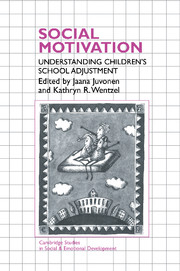Book contents
- Frontmatter
- Contents
- Contributors
- Preface
- Foreword
- 1 Introduction: New perspectives on motivation at school
- Part I Social motivation: Perspectives on self
- Part II Social motivation: Perspectives on relationships
- 9 Interpersonal relationships in the school environment and children's early school adjustment: The role of teachers and peers
- 10 Social goals and social relationships as motivators of school adjustment
- 11 Friends' influence on school adjustment: A motivational analysis
- 12 Peer networks and students' classroom engagement during childhood and adolescence
- 13 Academic failure and school dropout: The influence of peers
- 14 What's “emotional” about social motivation? A comment
- Author index
- Subject index
11 - Friends' influence on school adjustment: A motivational analysis
Published online by Cambridge University Press: 22 October 2009
- Frontmatter
- Contents
- Contributors
- Preface
- Foreword
- 1 Introduction: New perspectives on motivation at school
- Part I Social motivation: Perspectives on self
- Part II Social motivation: Perspectives on relationships
- 9 Interpersonal relationships in the school environment and children's early school adjustment: The role of teachers and peers
- 10 Social goals and social relationships as motivators of school adjustment
- 11 Friends' influence on school adjustment: A motivational analysis
- 12 Peer networks and students' classroom engagement during childhood and adolescence
- 13 Academic failure and school dropout: The influence of peers
- 14 What's “emotional” about social motivation? A comment
- Author index
- Subject index
Summary
Best friends can have a powerful influence on children's attitudes toward school, behavior in class, and academic achievement. The influence of friends has long been a concern of educators and educational researchers. Several decades ago, James Coleman (1961) argued that most high-school students care more about being popular with peers than about doing well in school, in part because their peers emphasize academic success less than social success. Many recent writers have echoed this theme (e.g., Bishop, 1989).
By contrast, other writers have emphasized the positive effects of friendships on children's adjustment and development. Piaget (1932/ 1965) proposed that interactions with friends or other peers are crucial for the development of a mature morality. Sullivan (1953) suggested that intimate friendships among preadolescents contribute to high self-esteem and to social understanding (Buhrmester & Furman, 1986). More recently, many researchers have tested the hypothesis that support from friends enhances the social and academic adjustment of children and adolescents (e.g., Berndt & Keefe, 1995).
Both perspectives on friends' influence capture part of the truth, but both are incomplete and therefore misleading. Friends influence children and adolescents through two distinct pathways (Berndt, 1992). First, students at all grade levels are influenced by the attitudes, behavior, and other characteristics of their friends. This influence is not always negative. Students whose friends have positive characteristics, such as high grades, are likely to improve their own grades over time (Epstein, 1983). One goal of our chapter is to outline various motives that account for friends' influence by this pathway.
Second, students are influenced by the quality of their friendships. For example, friendships are higher in quality when they are more intimate (Sullivan, 1953).
- Type
- Chapter
- Information
- Social MotivationUnderstanding Children's School Adjustment, pp. 248 - 278Publisher: Cambridge University PressPrint publication year: 1996
- 30
- Cited by



